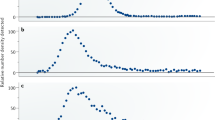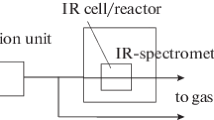Abstract
The thermochemical approach, using the quasi-equilibrium methodology of kinetic analysis and the concepts of equimolar and isobaric reaction modes (regimes), has been used to prove the common mechanism of the representative heterogeneous reactions: decompositions of CaCO3 and of Ag2O, reduction of NiO by H2, and the catalytic oxidation of CO and H2 on PtO2. All these rate processes have been analyzed using the congruent dissociative vaporization of the participating solid reactants or catalysts and are described by similar mechanistic schemes. The possible role of atomic oxygen evolution in oxidation catalysis is discussed. Quantitative proofs of the common mechanism of these reactions were provided by agreement between calculated reaction enthalpies and the Arrhenius E parameters, the retardation effect of gaseous products on the reaction rates, and the accordance between experimental and theoretical ratios of isobaric to equimolar values of the E parameter. In conclusion, milestones in the history of the thermochemical approach during the last century are discussed.


Similar content being viewed by others
References
L’vov BV. The mechanism of the thermal decomposition of metal nitrates in graphite furnaces for atomic absorption analysis. Zh Anal Khim. 1990;45:2144–53 (in Russian).
L’vov BV. Evaporation, thermal dissociation, carbothermal reduction and thermal decomposition of substances. A general approach to the theoretical calculation of kinetics. Book of abstracts, Invited lecture at XXVII CSI, Bergen; 1991, p. A-52.
L’vov BV. Thermal decomposition of solids and melts, new thermochemical approach to the mechanism, kinetics and methodology. Berlin: Springer; 2007.
L’vov BV. Thermochemical approach to solid-state decomposition reactions against the background of traditional theories. J Therm Anal Calorim. 2009;96:487–93.
L’vov BV. The mechanism of solid-state decompositions in a retrospective. J Therm Anal Calorim. 2010;101:1175–82.
L’vov BV. Theory of solid-state decomposition reactions: a historical essay. Spectrochim Acta B. 2011;66:557–64.
Volmer M. Über Keimbildung und Keimwirkung als Spezialfalle der heterogenen Katalyse. Z Elektrochem. 1929;35:555–61.
Schwab G-M. Katalyse vom Standpunkt der chemischen Kinetik. Berlin: Springer; 1931.
L’vov BV, Ryabchuk GN. Studies of the mechanisms of sample atomization in electrothermal atomic absorption spectrometry by analysis of absolute process rates. Oxygen-containing compounds. Zh Anal Khim. 1981;36:2085–96 (in Russian).
L’vov BV, Fernandez GHA. Regularities in thermal dissociation of oxides in graphite furnaces for atomic absorption analysis. Zh Anal Khim. 1984;39:221–31 (in Russian).
L’vov BV. Kinetics and mechanism of thermal decomposition of silver oxide. Thermochim Acta. 1999;333:13–9.
L’vov BV, Galwey AK. The mechanism and kinetics of NiO reduction by hydrogen: thermochemical approach. J Therm Anal Calorim. doi: 10.1007/s10973-011-2000-0.
L’vov BV, Galwey AK. Catalytic oxidation of CO on platinum: thermochemical approach. J Therm Anal Calorim. doi:10.1007/s10973-012-2241-6.
L’vov BV, Galwey AK. Catalytic oxidation of hydrogen on platinum: thermochemical approach. J Therm Anal Calorim. doi: 10.1007/s10973-012-2567-0.
Bodenstein M, Fink CG. Heterogene katalytische Reaktionen. Allgemeine Bemerkungen. Z Phys Chem. 1907;60:46–69.
Langmuir I. Chemical reactions on surfaces. Trans Faraday Soc. 1922;17:607–20.
Langmuir I. The mechanism of the catalytic action of platinum in the reactions 2CO + O2 = 2CO2 and 2H2 + O2 = 2H2O. Trans Faraday Soc. 1922;17:621–54.
Mitani K, Harano Y. Evolution of atomic oxygen from platinum surface treated previously with discharged oxygen gas. Bull Chem Soc Jpn. 1960;33:276.
Mitani K, Asakura Y. Detection of the atomic oxygen evolved in the decomposition of some metallic oxides. Bull Chem Soc Jpn. 1965;38:901–4.
L’vov BV, Novichikhin AV. Quantitative interpretation of the evaporation coefficients for the decomposition or sublimation of some substances in vacuo. Thermochim Acta. 1997;290:239–51.
L’vov BV. Kinetics and mechanism of thermal decomposition of mercuric oxide. Thermochim Acta. 1999;333:21–6.
L’vov BV, Ugolkov VL, Grekov FF. Kinetics and mechanism of free-surface vaporization of zinc, cadmium and mercury oxides analyzed by the third-law method. Thermochim Acta. 2004;411:187–93.
Royer S, Duprez D. Catalytic oxidation of carbon monoxide over transition metal oxides. ChemCatChem. 2011;3:24–65.
Langmuir I. The vapour pressure of metallic tungsten. Phys Rev. 1913;2:329–42.
Langmuir I. The constitution and fundamental properties of solids and liquids. J Am Chem Soc. 1916;38:2221–95.
Langmuir I. The evaporation of small spheres. Phys Rev. 1918;12:368–70.
Mars P, van Krevelen DW. Oxidations carried out by means of vanadium oxide catalysts. Chem Eng Sci. 1954;3:41–57.
Pease RN, Taylor HS. The reduction of copper oxide by hydrogen. J Am Chem Soc. 1921;43:2179–88.
Pease RN, Taylor HS. The catalytic formation of water vapor from hydrogen and oxygen in the presence of copper and copper oxide. J Am Chem Soc. 1922;44:1637–47.
Okayama J. Versuche über den autokatalytischen Verlauf bei Bildung und Reduktion des CuO. Z Elektrochem. 1928;34:294–8.
L’vov BV. Atomic absorption spectral analysis. Moscow: Nauka; 1966. (in Russian).
L’vov BV. Atomic absorption spectrochemical analysis. London: Adam Hilger; 1970.
Johnson DC, Sharp BL, West TS, Dagnall RM. Some observations on the vaporization and atomization of samples with a carbon filament atomizer. Anal Chem. 1975;47:1234–40.
Sturgeon RE, Chakrabarti CL, Langford CH. Studies on the mechanism of atom formation in graphite furnace atomic absorption spectrometry. Anal Chem. 1976;48:1792–807.
L’vov BV. Electrothermal atomization—the way toward absolute methods of atomic absorption analysis. Spectrochim Acta B. 1978;33:153–93.
L’vov BV, Bayunov PA, Ryabchuk GN. A macrokinetic theory of sample vaporization in electrothermal atomic absorption spectrometry. Spectrochim Acta B. 1981;36:397–425.
Sturgeon RE, Mitchell DF, Berman SS. Atomization of lead in graphite furnace atomic absorption spectrometry. Anal Chem. 1983;55:1059–64.
Bass DA, Holcombe JA. Mass spectral investigation of mechanisms of lead vaporization from a graphite furnace used in electrothermal atomizers. Anal Chem. 1987;59:974–80.
Dressler MS, Holcombe JA. Mass spectral and atomic absorption studies of selenium vaporization from a graphite surface. Spectrochim Acta B. 1987;42:981–94.
Wang P, Majidi V, Holcombe JA. Copper atomization mechanisms in graphite furnace atomizers. Anal Chem. 1989;61:2652–8.
L’vov BV, Novichikhin AV. Mechanism of thermal decomposition of anhydrous metal nitrates. Spectrochim Acta B. 1995;50:1427–48.
L’vov BV, Novichikhin AV. Mechanism of thermal decomposition of hydrated copper nitrate in vacuo. Spectrochim Acta B. 1995;50:1459–68.
Chorkendorff I, Niemantsverdriet JW. Concepts of modern catalysis and kinetics. Weinheim: Wiley-VCH Verlag GmbH; 2007.
Somorjai GA, Li Y. Impact of surface chemistry. PNAS. 2011;108:917–24.
Nilius N, Risse T, Schauermann S, Shaikhutdinov S, Sterrer M, Freund H-J. Model studies in catalysis. Top Catal. 2011;54:4–12.
Liu L, Qiao B, Zhou F, Yang B, Deng Y. Catalytic co-oxidation of CO and H2 over FeOx-supported Pd catalyst at low temperatures. J Catal. 2012;294:29–36.
Doherty RP, Krafft J-M, Mèthivier C, Casale S, Remita H, Louis C, Thomas C. On the promoting effect of Au on CO oxidation kinetics of Au–Pt bimetallic nanoparticles supported on SiO2: an electronic effect. J Catal. 2012;287:102–13.
Author information
Authors and Affiliations
Corresponding author
Rights and permissions
About this article
Cite this article
L’vov, B.V., Galwey, A.K. Toward a general theory of heterogeneous reactions. J Therm Anal Calorim 113, 561–568 (2013). https://doi.org/10.1007/s10973-012-2754-z
Received:
Accepted:
Published:
Issue Date:
DOI: https://doi.org/10.1007/s10973-012-2754-z




